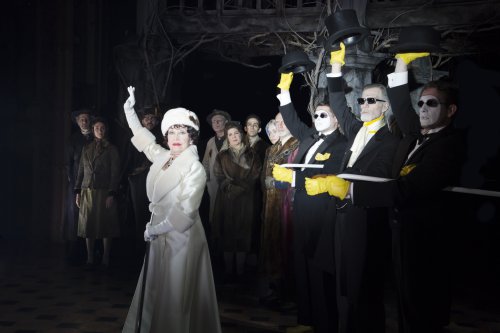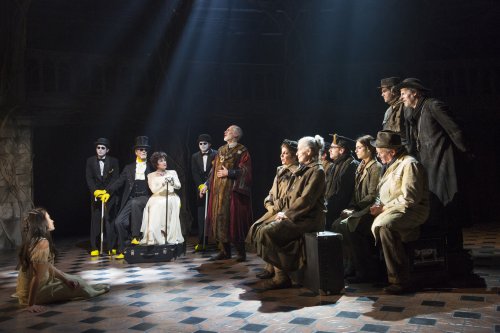The Visit
The last musical by John Kander and Fred Ebb starring the radiant Chita Rivera tells a tale of power and corruption, but unfortunately the book is thin.
[avatar user=”Stefan Woych” size=”96″ align=”left” ] Stefan Woych, Critic[/avatar] “Republicans Senators have come to the floor to defend the Koch brothers’ attempt to buy our democracy,” said Senator Harry Reid in an address to congress in March 2014. The possibility of one person or organization having too much power and who might buy the government is not new or alien to any society. The last musical by the Tony-Award winning composer/lyricist team John Kander and Fred Ebb, The Visit, based on the 1956 Swiss play by Friedrich Dürrenmatt, illustrates this sort of corruption in a tale about “the richest woman in the world,” Claire Zachanassian, (Tony winner Chita Rivera), who returns to her hometown after a 50-year absence to buy revenge for an injustice she suffered as a young girl. With a scaled-down book by Terrence McNally and grand scale direction by John Doyle, this satire of the debatable shortcomings of capitalism is a pot of soup of many delicious ingredients, but no substance.
Kander and Ebb’s score is pleasant enough, but does not live up to the canon of their great works. Although melodic and singable, the tunes are reminiscent of their other songs. “A Happy Ending” and “Yellow Shoes” are two lively and entertaining numbers where choreographer Graciela Daniele gets a chance to show her talents. The lyrics move the narrative forward with some clever lines by Ebb. Nonetheless, the songs are bland.
The illustrious Chita Rivera appears in an elegant floor length white dress and bedecked with jewels. The grande dame’s presence electrifies the audience. Unfortunately, with little to work with, she postures and delivers McNally’s lines the best she can. Along with co-star Roger Rees as Anton Schell, her lover from the old days, she breathes some life into the song, “You, You, You.” When she dances, the ball is back in her court. There is a magnificent moment when she dances with her younger self (Michelle Veintimilla). Sensitively choreographed by Daniele, they do a sweet dream-like duet with grace and passion, the highlight of the evening.
Claire offers the town and each citizen a huge amount of money in exchange for her revenge on Anton. At first they are appalled and refuse, but with time they are romanced by the financial possibilities. As the townspeople become more swayed by the idea of accepting Claire’s proposition, they each in turn buy yellow shoes, a color that is significant in this play. As Anton’s prospects look grimmer, his friends and family adorn more and more of this color. Doyle and Ward handle this detail to great effect. On the other hand, there are some major holes. Claire explains that she has an artificial leg and hand. A stiff gait and a cane reflect the leg, but the “ivory” hand is quite dexterous. This adaptation edits out so much of the original work, however this fact is kept while the reality ignored.
Originally written and performed in 1956, at which time women in Switzerland didn’t have the right to vote, Dürrenmatt made his protagonist a woman. He called the town Güllen, which means “to enrich by the application of manure.” A proponent of the rights of women and the proletariat, his word choice is not arbitrary. McNally’s adaptation calls the town Brachen, somewhere in Europe, with no mention of time. The book is a skeleton of the original on which to drape the Kander and Ebb songs. Dürrenmatt’s three-act play is reduced to an outline with one liners. Large amounts of exposition become punch lines. “I married very often and widowed very well,” says Claire to sum up 50 years of history. Some of the lines are funny, there is even a Polish joke. Nonetheless, this abbreviated version leaves many unanswered questions. It is never clear what the theme of this new musical is.
Doyle (2006 Tony Award for Best Direction of a Musical for Sweeney Todd) is a master at theatrics. A striking unit set by Scott Pask shows a grand series of columns overgrown by dead vines, a once flourishing old world town fallen into disrepair. The thoughtful costumes by Ann Hould-Ward allude to having once been luxurious but are now tattered and faded. The women in long dresses and men in waistcoats and long jackets do not specify the period. Doyle moves the actors around the stage like pieces on a chessboard, very stylized. While this is dramatic, it is often stilted. The musical is not robust enough to give this life.
Jason Danieley stands out as Frederich Kuhn, the schoolmaster who turns to alcohol over the town’s dilemma. “I didn’t agree at first,” he says to his friend Anton, “but having it drummed into my head convinced me.” In anguish he gives a moving performance when he sings, “The Only One” letting out a shout that is the only profound moment of this production. Rees gives a lackluster performance as Anton. The cast as an ensemble fulfill their role under Doyle’s direction, but there are no shining performances.
This is a polished piece with some fine talent at the helm. Regrettably, there is little ballast.
The Visit (through June 14, 2015)
Lyceum Theatre, 149 West 45th Street in Manhattan
For tickets, call 212-239-6200 or visit http://www.thevisitmusical.com
Running time: 100 minutes with no intermission.








I think the integrity of the work is that ‘it is never clear what the theme… is’. I loved this piece for its subtlety. The performances reflected perfectly the melancholy of the play. There was no pandering or forced opinions, no jazz hands, and it is beautiful. If you love theater, and are tired of the jukebox-disney version of Broadway then you will appreciate this work of art. It is subtle. It is sensitive. You will get what you get from it, and perhaps it will take you months to truly figure out what it is that it has left you with. When you say that ‘it leaves many unanswered questions’, I say that is my favorite part.